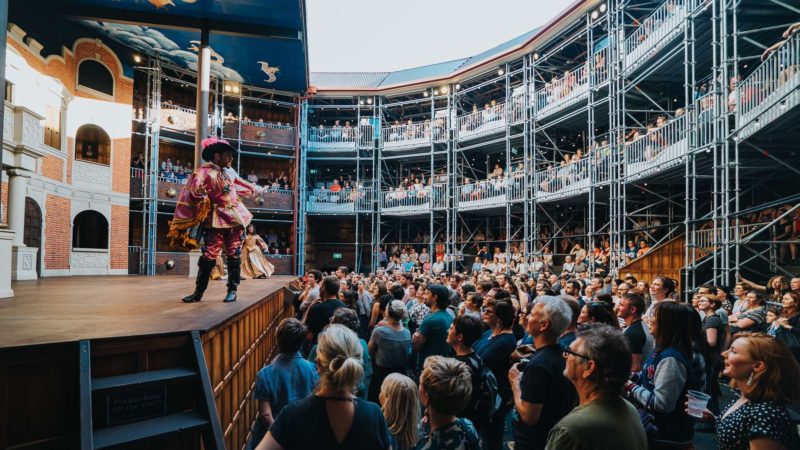‘I hold the world but as the world, Gratiano, / A stage where every man must play a part’ – Antonio, Act 1, Scene 1.
If you’ve been on social media at all over the past few months, there’s a chance you know about the much-hyped Pop-Up Globe (PUG) coming to Sydney this month. Much like the Sydney Fringe Festival (also running right now), the PUG season provides a unique theatre experience that permanently-running theatres simply don’t have the ability to emulate.
For a limited time, audiences can – quite literally – experience the classical plays of Shakespeare, performed in their traditional Shakespearean verse, in a flawless copy of his original Globe Theatre.
Conceptualised in 2015 by New Zealand-based Artistic Director Miles Gregory (whose PhD dissertation focused on Shakespeare in Performance), the PUG made its first appearance in Auckland, commemorating the 400th anniversary of Shakespeare’s death. It draws upon specific research into the dimensions, architectural style, and archaeological remains of the original Globe conducted by Sydney University Associate Professor Tim Fitzpatrick – who virtually reconstructed it in a groundbreaking research paper. It is the world’s first and only perfect full-scale working replica of the Globe Theatre. The 900-person audience space, in-the-round stage dimensions, traditional musical instruments, and Jacobean aesthetic is completely as it was during Shakespeare’s time; groundling pit, open-air, and all-male cast included.

For these reasons and more, when watching one of PUG’s shows play out, it is exactly as Miles intends it to be – not ‘dusty Shakespeare’, but ‘like a party’. As one enters the Globe, they immediately see the cast milling around on stage. They’re not doing much, but it is not their actions that surprise us. It is their costumes. Flamboyant fur coats, vibrant, flowing dresses and decadent hats create an extravagant visual landscape for us before a word is even spoken. Further, what is just as (if not more) interesting are the people wearing these costumes. As this is an all-male cast, they have to step into the shoes of Shakepeare’s female characters with as much grace and poise as a woman would. Jessica, daughter of Shylock and Lorenzo’s love interest, is played by the tall, broad-chested Maori actor Reuben Butler. Thomas Wingfield, a Benedict Cumberbatch-like figure with a wig of flowing black hair, plays Nerissa, Portia’s maid and Gratiano’s love interest. It takes time to warm up to seeing these alpha male body types play such exposed female roles It also makes for some rather interesting love scenes later on (wording it conservatively).
From the get-go everyone, from the standing groundlings to the Royal Room ‘elite’, is invited to participate in the action, with the cast often breaking the fourth wall to ridicule, glorify, embarrass or roast us and our reactions. This is best seen in any moment involving Portia’s various suitors – our cheers and applause for the Prince of Arragon’s eclectic performance, drawing a surprised and confused ‘For him?’ from the woman who just broke his heart, is but one example of many. Even when this doesn’t happen, the show keeps you ensnared, never faltering in engaging with its audience. Complicated Shakespearean dialect is contrasted with joyous dancing and song-singing, making the entire night’s affair merry and cheerful (as The Merchant of Venice is designed to be), as well as accessible to an audience that doesn’t live and breathe theatre. This versatile and accessible performance is why, even as a groundling, anyone can make it through two-plus hours of Shakespeare (though a substantial amount of mulled wine available just outside the theatre at a reasonable price and comfortable shoes do help).
Even if one doesn’t want to drink, the groundling experience is just as fun. Just like Elizabethan England, the higher the seats, the greater the luxuries (and by association, the more upper-class the people). The ‘VIPs’ sit in seats located around the upper edges of the structure, portraits of Elizabethan nobility decorating lush red walls that encase velvet seats. Further down, we have the middle-class; with seats akin to a movie theatre (with much smaller cushions and no decoration). Finally, on the ground, we have the working-class; forced to stand and peer over the shoulders of others. Ironically, it is this final group that are the most involved. Heckling is encouraged. Characters, in moments where they are on stage but not speaking, have hushed conversations with this group. They get the complete frontal view of the performance, whereas those higher up see all the action side-on. Economically, groundling tickets are dirt cheap as well, which means more money for merchandise, food and drink!

Due to this cheeriness, the play’s romantic subplot is its strength – even though the story is traditionally focused on the repayment of a 3,000-ducat bond between Shylock, a Jewish merchant, and Antonio, whose money is all at sea, on behalf of his friend Bassanio (who wants to woo wealthy Venetian Portia). Nonetheless, Patrick Carroll’s performance as Portia exudes an interesting masculinity that meshes uniquely well with the audience and her other characters, particularly the comic (and potentially a bit too devoted to Antonio) Basanio (Josh Cramond). Lorenzo and Jessica mirror the confusing gender-bending of Nerissa and Gratiano to great humorous effect. This is seen no better than in the latter stages of the play, particularly the famous trial scene and when the three couples bicker over the importance of wedding rings. It would be remiss not to give Thomas Wingfield his own special shout-out; his scene-stealing performance as Nerissa is sassy, saucy and spectacular all in one. He and the rest of cast are having fun, and by association so are we.
However, this fun doesn’t play out as well with the play’s more dramatic moments. As an audience, we never quite grasp the tension between Antonio (Jonathan Martin) and Shylock (Peter Daubé) – they are both too reserved in their characterisation. This is unfortunately more so the case with Daubé. He chooses not to present a devious Shylock or a humane one, but rather something in the middle. Subsequently, the importance he places on his faith isn’t noticed. The symbolic impact of his ring is lost. We never comprehend why he hates Antonio, or even if he hates him at all. We’re more or less left to hate him because we know that’s what how we’re supposed to react to him. The losses he faces are subsequently in some ways joyous to us – simply so we can get back to the numerous love stories. An unfortunate sacrifice, leaving me feeling like I missed out.
Ultimately, if all you’re looking for is two hours of plain good fun, then this will leave you more than satisfied. If you’re looking for as realistic a Shakespearean experience as possible, you’ll find exactly this. However, if you want an intellectual commentary, it’s not here. But nerds have never been fun at parties anyway.

